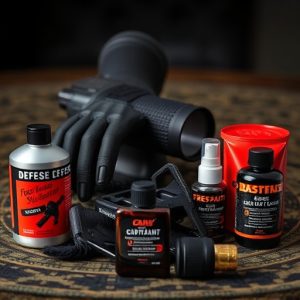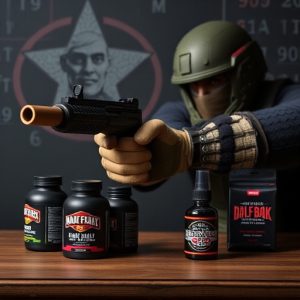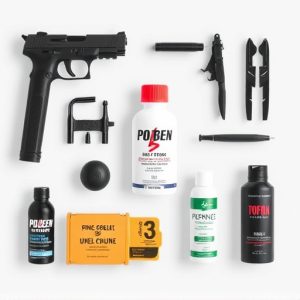Navigating Personal Defense Products: A Guide to Less Lethal Weapons and Legal Use
Personal defense products have become integral to modern self-defense strategies, offering a range …….
Personal defense products have become integral to modern self-defense strategies, offering a range of non-lethal options including pepper spray, stun guns, and sophisticated apps for personal safety. These tools are designed to temporarily incapacitate attackers while minimizing the risk of serious injury, with traditional devices like pepper spray and stun guns being complemented by tech-savvy alternatives like self-defense apps that offer real-time assistance and instructional content. It's crucial for users to understand and comply with local laws regarding these products, as their ownership, carrying, and use are subject to jurisdiction-specific regulations. The legality of each product type varies, and responsible marketing by manufacturers is key to maintaining the integrity of personal defense products. Technological advancements have led to lighter, more resilient defensive gear, with compact devices like keychain pepper spray units offering effective protection. The future of personal defense is poised to be transformed by smart technology integration, including wearables for early threat detection and GPS tracking, body cameras for legal documentation, virtual reality for enhanced training, and AI-enabled non-lethal weapons for personalized defense solutions. These developments reflect a commitment to enhancing the safety and effectiveness of personal defense products in an evolving security landscape.
When considering the spectrum of personal defense products, it’s crucial to understand their role in modern self-defense strategies. These tools serve as a deterrent against physical harm and are integral to individuals’ safety plans. This article delves into the types of less lethal weapons, including pepper spray, stun guns, and Tasers, and examines the legal frameworks that govern their use. It also assesses the effectiveness of these products and the training necessary for proficient handling. In addition, innovative advancements in personal defense technology promise to shape future trends, ensuring these products remain effective in an ever-evolving threat landscape.
Overview of Personal Defense Products and Their Role in Modern Self-Defense Strategies
Personal defense products have become an integral component of modern self-defense strategies, offering individuals a range of options to protect themselves in potentially threatening situations. These products encompass everything from non-lethal weapons like pepper spray and stun guns to personal security alarms and advanced self-defense apps. The evolution of personal defense products reflects a societal shift towards prioritizing safety without resorting to fatal force. Pepper spray, for instance, is a widely recognized tool that temporarily incapacitates an attacker by causing intense irritation to the eyes and respiratory system, providing the user a window of escape. Stun guns deliver a high-voltage electric shock, effectively neutralizing an aggressor while minimizing the risk of permanent harm. Beyond physical devices, personal defense apps are emerging as tech-savvy solutions, offering real-time location sharing, instant access to emergency services, and self-defense training videos. These tools underscore the importance of empowering individuals with effective, non-lethal means to deter and defend against assault, robbery, and harassment, thus playing a crucial role in contemporary personal safety measures. Users of these products can rely on them for immediate protection, knowing that they are part of a comprehensive self-defense strategy tailored to the modern landscape.
Types of Less Lethal Weapons for Personal Defense: Pepper Spray, Stun Guns, and Tasers
When considering personal defense products that offer a less lethal approach, it’s crucial to understand the capabilities and limitations of each type. Pepper spray is a widely recognized tool for self-defense, often considered a first line of defense due to its non-permanent effects. It incapacitates an attacker by causing intense irritation to the eyes and mucous membranes, temporarily impairing their vision and ability to breathe. This gives the user time to escape or seek help. Stun guns, another effective personal defense product, deliver a high-voltage electrical charge that overwhelms voluntary muscle control, effectively rendering an attacker immobile without causing long-term harm. They are designed to be straightforward to use, often with a simple push of a button. Tasers fall into a category between pepper spray and stun guns, delivering two barbed probes connected by conductive wires that deliver a high-voltage electrical current intended to neutralize an assailant. These devices can be particularly effective at a distance and are known for their quick onset of effects. All three options are designed with personal defense in mind, offering varying levels of range and incapacitating power while aiming to minimize the potential for serious injury or fatality. Users should familiarize themselves with the laws governing these products in their jurisdiction and practice using them under the guidance of a professional instructor. This ensures that they are prepared to use these personal defense products effectively and lawfully if the need ever arises.
Legal Considerations and Regulations Surrounding Personal Defense Products
In the realm of personal safety, legal considerations and regulations surrounding the use of personal defense products are paramount. These products, which range from pepper spray to stun guns and Tasers, are designed to incapacitate an assailant without causing permanent injury or death. The legality of these items varies by jurisdiction; while some regions allow a wide array of self-defense tools, others impose strict restrictions. It is imperative for individuals to familiarize themselves with local laws as they pertain to the ownership, carrying, and use of personal defense products. Laws may dictate age limitations, licensing requirements, and permissible uses in public or private spaces. Understanding these regulations is crucial for legal compliance and ensuring one’s safety without exposing oneself to unnecessary legal repercussions.
Moreover, the regulations often differentiate between various types of personal defense products based on their level of force and incapacitation potential. For instance, some devices may be legally sanctioned for home defense but prohibited for public carry. The manufacturers and vendors of these products are equally bound by legal standards to accurately represent their products’ capabilities and to ensure they are marketed responsibly. It is through adherence to these laws and regulations that the integrity of personal defense products as tools for self-defense can be maintained, thereby upholding public safety and individual rights.
Effectiveness and Training Requirements for Personal Defense Products
When considering personal defense products as a means of protection, the effectiveness of these tools is paramount. High-quality personal defense products are designed to incapacitate an aggressor without causing permanent harm, making them suitable for self-defense scenarios where lethal force would be disproportionate. These devices range from pepper sprays and stun guns to tactical flashlights and personal alarms. Each product requires specific training to ensure proper use; otherwise, they may not function as intended. Training for personal defense products should include understanding the legal implications, situational awareness, and hands-on practice with the chosen device. Proficiency in these tools is essential for users to effectively deter threats, as each product has unique characteristics that affect its performance in real-world situations. Users must be well-versed in the correct deployment techniques and aware of the local laws governing the use of such products to avoid legal repercussions. Training programs often cover these aspects, providing individuals with the confidence and skills necessary to protect themselves effectively while adhering to legal boundaries. Regular practice and staying informed about product updates are also crucial for maintaining proficiency with personal defense products.
Innovative Advancements in Personal Defense Technology and Future Trends
The landscape of personal defense products has seen significant advancements in recent years, with technology playing a pivotal role in enhancing safety and effectiveness for individuals. Innovations in materials science have led to the development of lighter and more durable defensive gear, while miniaturization trends have enabled the creation of compact yet potent devices capable of deterring threats. For instance, pepper spray now comes in keychain-sized models that are as effective as their larger counterparts but more convenient to carry. Similarly, stun guns have evolved to incorporate rechargeable batteries and LED flashlights, providing both a defensive tool and a light source in one compact unit.
Looking ahead, the future of personal defense products is poised to be shaped by smart technology integration. Wearables equipped with motion detectors and GPS are anticipated to alert users to potential threats, while body cameras could record incidents for evidence and review. Advanced training simulations powered by virtual reality (VR) will enable individuals to practice defensive maneuvers in a controlled environment. Additionally, the emergence of non-lethal weapons with AI capabilities will offer personalized defense strategies based on situational analysis. These developments promise to democratize access to effective self-defense measures, ensuring that individuals have an array of sophisticated tools at their disposal to protect themselves and their loved ones in an increasingly complex world.


